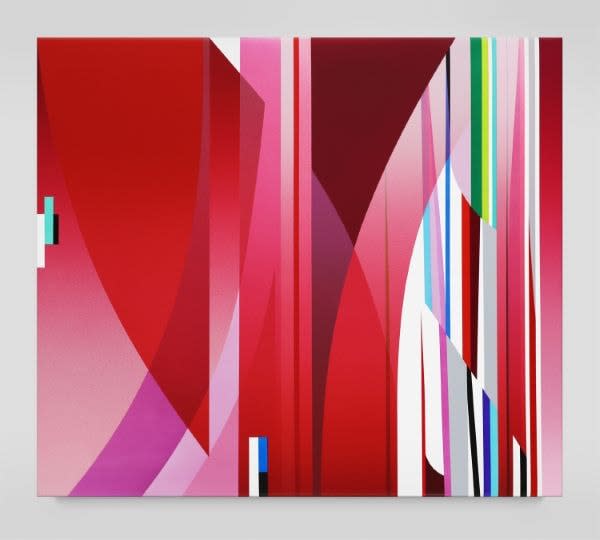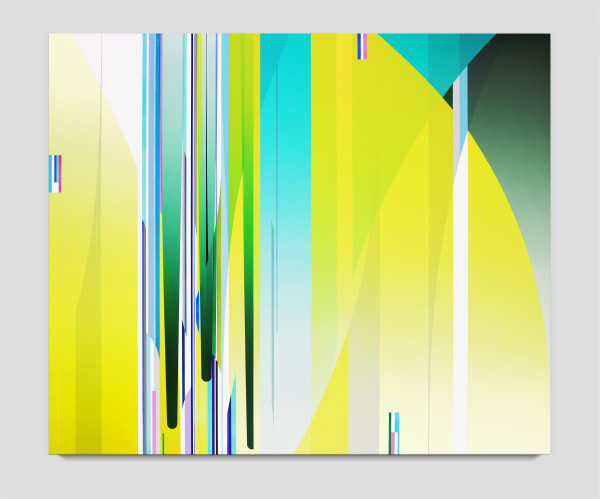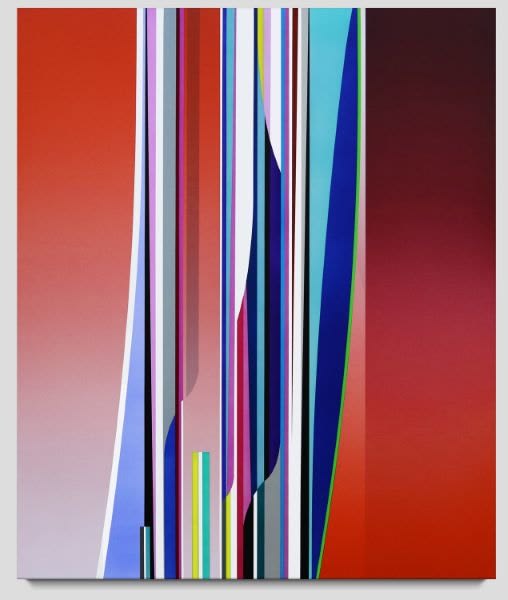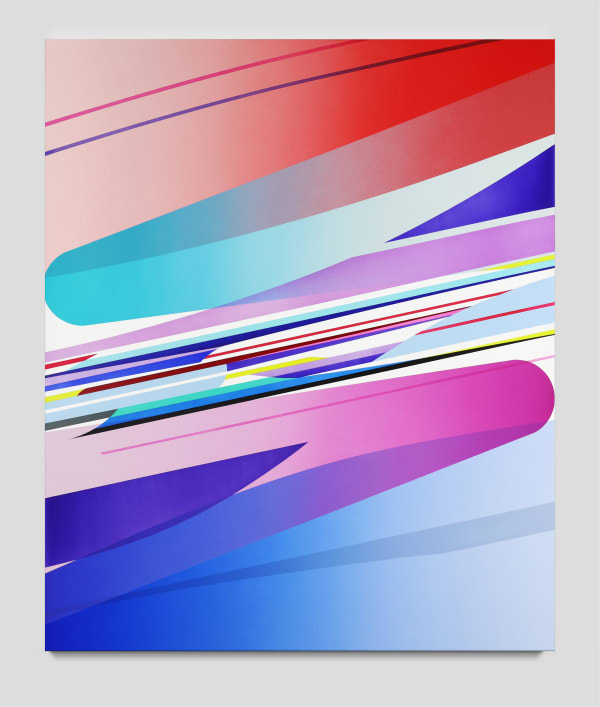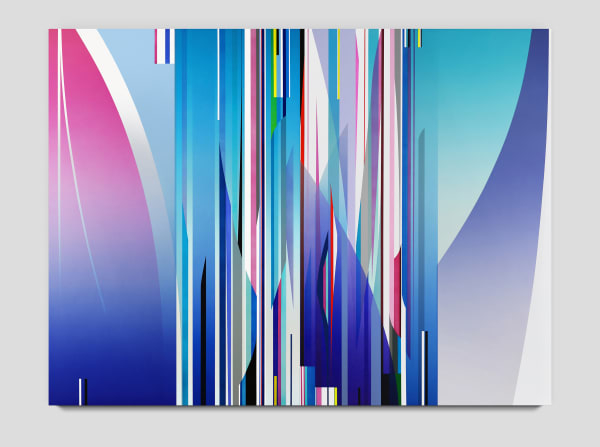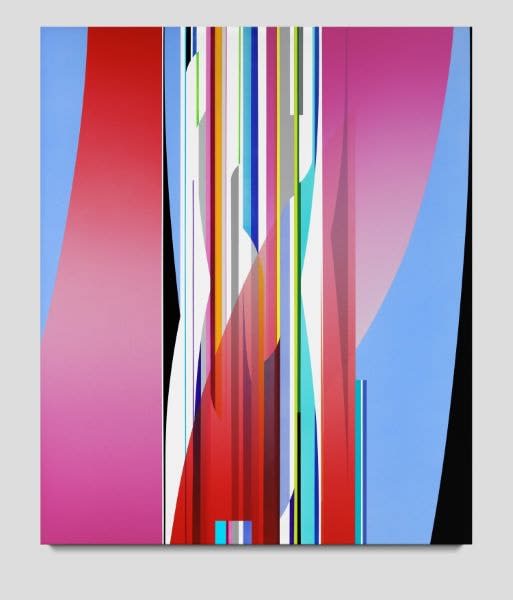Dion Johnson speaks to Los Angeles art curator, Ed Schad about the influences and inspiration behind his recent series of paintings.
DION JOHNSON IN CONVERSATION WITH ED SCHAD
May 2025
Ed Schad
My first question would be about something that I can't get out of my mind since I recently visited your studio. You mentioned that you had sympathy with Dave Hickey's idea that an artist should push to their limit and then make that one's center. What did you mean by that? For a practice rooted in colors, shapes, and ultimately in service to abstraction, I would guess that would be an interesting place to start.
Dion Johnson
I take Dave Hickey’s idea to be good advice - succinct, pragmatic, and motivational. I think abstract paintings are adventures; they are visual experiences that can take us somewhere we have never been and fill us with a sense of wonder. While my canvases often start as an idea or sketch that relates to a previous work, I want every painting I make to have a surprise, something new. This could be how I mix layers of colors, create a set of interlocking shapes, or combine hues that allude to music or a memory. When I’m painting, I am never solving the same puzzle. The adventure is most exciting when I find myself in new creative territory and, if it feels right, I get to make that my center.
ES
I want to ask you about some of those allusions to music and memories. Could you give some examples and how they follow you as you make your way into and through a composition? One of the beautiful mysteries of abstract painting is how strange visual languages develop out of someone's life, and I wondered if you could speak to that a bit in terms of your work.
DJ
A short while back, I was drawing pairs of converging s-curves thinking that the negative space between the edges could playfully divide two gradient areas by stretching from the upper left to the lower right of a canvas. As I made more drawings - tilting the incline, adjusting the curves – I recalled summertime family get-togethers when my cousins and I were kids. We loved this specific playground that had a big blue s-curve shaped slide. It was so wide that three of us could ride down side by side at the same time. Sharing the fun was thrilling, and that bright blue seemed to make the slide faster and more exciting. I made four “Slide” paintings, and each work has a different palette. It’s worth noting that Slide 1 has a lot of blue.
In music, sounds from multiple instruments can blend and intertwine to create dynamic sonic spaces. Similarly, I want to paint translucent colors to create layered visual environments. Voile is a fairly large painting in this vein. When I was doing preparatory drawings in Photoshop, trying to nail down an ambitious composition, I was listening to Claude Debussy. One song stood out as particularly airy and active; the music seemed to be in sync with my color choices and the compositional tension of compressing and expanding shapes. The title of the Debussy piece is Voiles referring to translucent veils or wind-blown sails. That’s pretty spot on.
ES
I want to go into the Slide paintings a bit more, as Slide 2 was a painting we had fun thinking about in your studio. I mentioned at the time that it reminded me of citrus, that it was a collision of oranges and lemons and limes, and so I would be tempted to turn this painting into a sort of summertime idyll where I would dream of slides and open spaces and picnic tables set with rich, lush fruits, and that would be fun and satisfying to think about. However, your paintings are always more than a read like that, especially as other interventions in these moods become legible; your soaring, cathedral like verticals, the two-step of opaque and translucent colors, the staccato "mini-John McLaughlins" that descend or ascend from the edges. How does the experience of a specific memory accumulate and thicken for you into something this complicated? You mention drawing, but you also talk about moments of accident and spontaneity.
DJ
Your perception of citrus fruit and a pleasant summertime environment definitely resonates with me, and it relates to an earlier work from 2023, Citrus Glow, a small painting with a luminous yellow palette suggestive of a tangy mixture of lemons and limes. Because Slide 2 is 60 x 72 inches, there is plenty of room to build a rich layered experience. Colors as flavor sensations are set in motion by a childhood memory, and imaginary architectural spires ascend through gradients of citrus sunshine - numerous intersections of stimuli invite viewers to explore and discover. I think "mini-John McLaughlins" is a great name for the multi-color blocks hugging this piece's top edge and right side. These have appeared along the edges of numerous canvases, but in Slide 2, I think of them as drifting thoughts in the periphery of a summertime scenario.
Drawing is a way of organizing ideas, selecting colors, and planning a direction. My drawings are counterbalanced by spontaneity. This instinct to make reactive decisions while layering wet colors and seeing the stages of compositional development is exciting and essential. For practical purposes, I tend to paint as fast as I can, and in doing so, things don’t always turn out the way I want or expect. You can call these accidents, misjudgments, or errors, but if a color, layer, or shape isn’t helping the painting, it’s probably hurting, and I need a compelling solution. This might be painting over a background element to create a strong foreground shape, which is how the white cathedral-like vertical appeared on the right side of Slide 2 and ultimately finished the piece.
ES
That was a wonderful answer. I remember thinking in your studio that many of your new paintings reminded me of some moments in Abstract Expressionism, where one encounters large, sweeping structures counterbalanced with smaller, arresting incidents. I think of how interesting a Barnett Newman tape mark can be on the side of one of his zips, how little splatters matter a great deal to the sweeps of Motherwell's Elegies. However, speaking to you about some of your painting inspirations, I was happy to find myself farther afield, in Winslow Homer, in Dutch Church painters, and in Corot. Could you take us through the web of some of those inspirations, perhaps talk about some of what you were looking at were inspired by in this new body of work?
DJ
Thank you, Abstract Expressionism is a nice entry point. After being introduced to Hans Hofmann’s “push pull” idea of colors advancing, receding and hovering parallel to a painting’s surface, I saw Barnett Newman’s zips as a cracked open door where one can see a vertical strip of warm light or a cool darkness emanating from another room, or maybe from an infinite depth. Skipping through art history is fun. It’s not a big leap for me to connect the little splatters that energize Robert Motherwell's Elegies to the splashing sea sprays in Homer’s dynamic marine environments. I’m fascinated by Corot’s trees, which seem to be dissolving as they absorb or reflect luminous sunlight and sky color. I’m also quite keen on the angles and curvatures found in Dutch paintings of church architecture. In my work, I want to create a playful tension between atmospheric spaces and hard-edge structures - this desire has a dialog with Corot’s landscapes and Dutch interiors.
Most recently, I have introduced shapes with interlocking convex and concave curves. These are inspired by Casper David Friedrich’s nocturnal seascape skies, where moonlight reveals subtle elongated cloud curvatures. After seeing his major exhibition in Berlin, I made drawings based on a few photographs I took. At first the drawings were dense, but then they became more minimal and open. I found that turning these curvy drawings vertical and having them overlap other areas created a wave flow momentum - this felt similar to the movement on a Morris Louis or Helen Frankenthaler color field canvas. While I identify with landscape painting, I’m not sure if anyone would guess that my abstracted cloud forms are so directly influenced by Friedrich’s romantic sublime.
ES
I think your reference to "hard-edge structures" makes me want to ask you what I think is an important question, of how you relate to a vibrant hard-edge tradition here in Los Angeles? We have spoken of Helen Lundeberg often together and I know that we share a mutual admiration for Frederick Hammersley. If we added Karl Benjamin and Lorser Feitelson -- artists who I suspect you also admire -- we have quite a legacy here in L.A. I would love to know how you relate to these painters, what you take from them and what you rub up against when you work? To be honest, I have never thought of Feitelson in relation to your work until right now, but your description of atmospheric spaces and wave flow momentum brings him to mind.
DJ
Yes, a good question. In graduate school I studied with Karl Benjamin, and I got to know him and his paintings pretty well. Years later I began using masking tape to make compositions with vertical colors. Around that time, I visited Karl at his home, and while we were enjoying some bear claw pastries, he playfully commented on my recent paintings, saying, “So, you finally figured it out.” I miss Karl.
I feel a strong connection to Frederick Hammersley and Helen Lundeberg. Hammersley’s geometric and organic abstractions are so inventive and playful. I think about his paintings as adventures and puzzles, qualities I want in my work. The places in Lundeberg’s work are fascinating - landscapes, architecture, and outer space scenes elegantly transition into abstractions of shape and color. Sometimes, my paintings are like abstract places informed by personal experiences. Layers of colors may allude to my view of the San Gabriel Mountains bathed in magenta light at sunrise, and aerodynamic shapes in a composition may suggest my peripheral perspective during a bicycle ride.
Recently, I visited a Lorser Feitelson exhibition at Louis Stern Fine Arts with fellow L.A. painter Heather Gwen Martin. This show was fun to see with Heather as I relate to how she paints energetic shapes and vivid colors. The Feitelson pieces had surrealist aspects as well as hard-edge abstraction. His combination of illusionistic space and solid shapes presented lively settings in which curved color planes seem to warp, float, and pirouette. Something that I love about abstract painting, which can certainly be found in Feitelson’s work, is a sense of movement and momentum. In my recent paintings, I am excited to make advancing and receding atmospheric spaces with hard-edged gradient fields, where curvilinear shapes move in wave currents amid rectilinear colors that stretch up and down.
ES
We have talked about the gradients being a break-through in your practice. Could you talk about how your use of gradients came about and how they fit in? Also, in a related question, you have started to make paintings in your recent body of work that turn your paintings horizontal. How did that come about and how do you think about these new works in relation to your practice?
DJ
For a while now, I have been using colors with a great deal of acrylic medium, which makes them translucent. These passages tended to be narrow bands or medium-sized shapes, and when they were adjacent to or overlapping large areas of opaque colors, they would seem to flicker or reflect light. Then I thought, what would spray-applying large areas of translucent color look like? I experimented by painting isolated sections with a single gradient hue. Before long, multiple translucent planes were intersecting and crossfading. This was fascinating; the gradient colors became energy and light.
The first couple of paintings I made in 2025 have slender interlocking shapes that stretch from side to side through the center of the composition. These multi color groupings are oriented on a subtle angle that implies a twisting motion. Above and below the concentrated center activity, pairs of gradient fields seem to accelerate the rotation. I was thinking of a spinning coin’s wobbling angular axis just before it reaches its horizontal resting point. This horizontal space, imbued with a gyroscopic momentum, feels like a nice extension of my current practice and a new color adventure.
Ed Schad is Curator and Publications Manager at The Broad in Los Angeles, where he has curated large-scale exhibitions of the work of Takashi Murakami, Shirin Neshat, William Kentridge, and Mickalene Thomas. His writing has appeared in Art Review, Frieze, the Brooklyn Rail, and the Los Angeles Review of Books. His first collection of poems, Letters Apart, was published in 2023 by Dopplehouse Press.
Dion Johnson is based in Los Angeles and has exhibited widely around the United States. His works can be found in the permanent collections of the Columbus Museum of Art, Columbus, OH; Twitter Inc., Santa Monica, CA; Capital Group Companies, Los Angeles, CA; Museum of Art and History, Lancaster, CA; Creative Artists Agency, Los Angeles, CA; and Pizzuti Collection, Columbus, OH. His work has been reviewed and featured in the Los Angeles Times, Artforum, Artnews, HuffPost, Artillery, Art and Cake, and The New York Times.


